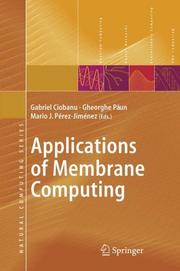| Listing 1 - 10 of 175 | << page >> |
Sort by
|
Book
ISBN: 6612956275 1282956272 9786612956270 1607506610 9781607506614 9781607506607 1607506602 Year: 2010 Publisher: Amsterdam Washington, DC IOS Press
Abstract | Keywords | Export | Availability | Bookmark
 Loading...
Loading...Choose an application
- Reference Manager
- EndNote
- RefWorks (Direct export to RefWorks)
This book presents the proceedings of the First International Conference on Biologically Inspired Cognitive Architectures (BICA 2010), which is also the First Annual Meeting of the BICA Society. A cognitive architecture is a computational framework for the design of intelligent, even conscious, agents. It may draw inspiration from many sources, such as pure mathematics, physics or abstract theories of cognition. A biologically inspired cognitive architecture (BICA) is one which incorporates formal mechanisms from computational models of human and animal cognition, which currently provide the o

ISBN: 1280969393 9786610969395 3540299378 3540250174 Year: 2006 Publisher: Berlin ; New York : Springer,
Abstract | Keywords | Export | Availability | Bookmark
 Loading...
Loading...Choose an application
- Reference Manager
- EndNote
- RefWorks (Direct export to RefWorks)
Membrane computing is a branch of natural computing which investigates computing models abstracted from the structure and functioning of living cells and from their interactions in tissues or higher-order biological structures. The models considered, called membrane systems (P systems), are parallel, distributed computing models, processing multisets of symbols in cell-like compartmental architectures. In many applications membrane systems have considerable advantages – among these are their inherently discrete nature, parallelism, transparency, scalability and nondeterminism. In dedicated chapters, leading experts explain most of the applications of membrane computing reported so far, in biology, computer science, computer graphics and linguistics. The book also contains detailed reviews of the software tools used to simulate P systems.
Molecular computers. --- Biologically-inspired computing. --- Biologically-inspired computing --- Bio-inspired computing --- Natural computing --- Bionics --- Electronic data processing --- DNA-based computers --- DNA computers --- Biocomputers --- Natural computation
Book
ISBN: 0128017430 0128015381 133600892X 9780128017432 9781336008922 9780128015384 9780128015384 Year: 2015 Publisher: Waltham, Massachusetts : Morgan Kaufmann,
Abstract | Keywords | Export | Availability | Bookmark
 Loading...
Loading...Choose an application
- Reference Manager
- EndNote
- RefWorks (Direct export to RefWorks)
Bio-inspired computation, especially those based on swarm intelligence, has become increasingly popular in the last decade. Bio-Inspired Computation in Telecommunications reviews the latest developments in bio-inspired computation from both theory and application as they relate to telecommunications and image processing, providing a complete resource that analyzes and discusses the latest and future trends in research directions. Written by recognized experts, this is a must-have guide for researchers, telecommunication engineers, computer scientists and PhD students.
Telecommunication. --- Biologically-inspired computing. --- Biologically-inspired computing --- Bio-inspired computing --- Natural computing --- Bionics --- Electronic data processing --- Electric communication --- Mass communication --- Telecom --- Telecommunication industry --- Telecommunications --- Communication --- Information theory --- Telecommuting
Book
ISBN: 1424477069 1424477050 Year: 2010 Publisher: [Place of publication not identified] IEEE
Abstract | Keywords | Export | Availability | Bookmark
 Loading...
Loading...Choose an application
- Reference Manager
- EndNote
- RefWorks (Direct export to RefWorks)
Natural computation --- Computational intelligence --- Biologically-inspired computing --- Bio-inspired computing --- Natural computing --- Bionics --- Electronic data processing
Book
ISBN: 1479951501 1479951528 147995151X Year: 2014 Publisher: Piscataway, New Jersey : Institute of Electrical and Electronics Engineers,
Abstract | Keywords | Export | Availability | Bookmark
 Loading...
Loading...Choose an application
- Reference Manager
- EndNote
- RefWorks (Direct export to RefWorks)
Natural computation --- Biologically-inspired computing --- Bio-inspired computing --- Natural computing --- Bionics --- Electronic data processing
Book
ISBN: 0128119004 012811889X 9780128119006 9780128118894 9780128118894 Year: 2018 Publisher: London, England : Academic Press,
Abstract | Keywords | Export | Availability | Bookmark
 Loading...
Loading...Choose an application
- Reference Manager
- EndNote
- RefWorks (Direct export to RefWorks)
Natural computation. --- Biologically-inspired computing --- Bio-inspired computing --- Natural computing --- Bionics --- Electronic data processing
Book
ISBN: 9781119681984 Year: 2021 Publisher: London, England : Academic Press,
Abstract | Keywords | Export | Availability | Bookmark
 Loading...
Loading...Choose an application
- Reference Manager
- EndNote
- RefWorks (Direct export to RefWorks)
Natural computation. --- Biologically-inspired computing --- Bio-inspired computing --- Natural computing --- Bionics --- Electronic data processing
Book
ISBN: 1538621657 1538621665 Year: 2017 Publisher: Piscataway, New Jersey : Institute of Electrical and Electronics Engineers,
Abstract | Keywords | Export | Availability | Bookmark
 Loading...
Loading...Choose an application
- Reference Manager
- EndNote
- RefWorks (Direct export to RefWorks)
Natural computation --- Fuzzy systems --- Biologically-inspired computing --- Bio-inspired computing --- Natural computing --- Bionics --- Electronic data processing
Book
ISBN: 9811613540 9789811613548 9811613532 Year: 2021 Publisher: Singapore : Springer,
Abstract | Keywords | Export | Availability | Bookmark
 Loading...
Loading...Choose an application
- Reference Manager
- EndNote
- RefWorks (Direct export to RefWorks)
Natural computation. --- Natural computation --- Biologically-inspired computing --- Bio-inspired computing --- Natural computing --- Bionics --- Electronic data processing
Book
ISBN: 3030736032 3030736024 Year: 2021 Publisher: Cham, Switzerland : Springer,
Abstract | Keywords | Export | Availability | Bookmark
 Loading...
Loading...Choose an application
- Reference Manager
- EndNote
- RefWorks (Direct export to RefWorks)
Natural computation --- Biologically-inspired computing --- Bio-inspired computing --- Natural computing --- Bionics --- Electronic data processing
| Listing 1 - 10 of 175 | << page >> |
Sort by
|

 Search
Search Feedback
Feedback About UniCat
About UniCat  Help
Help News
News